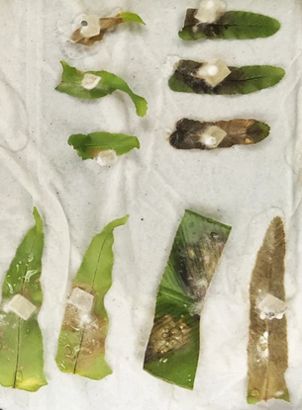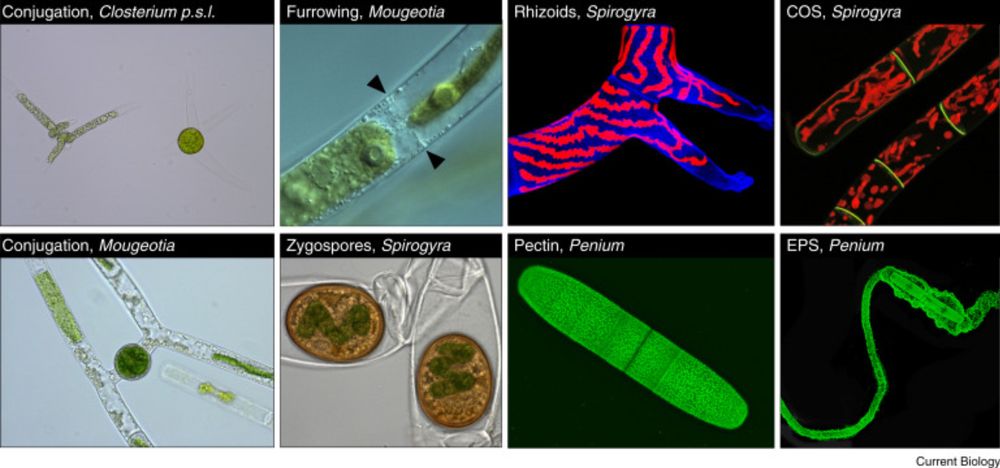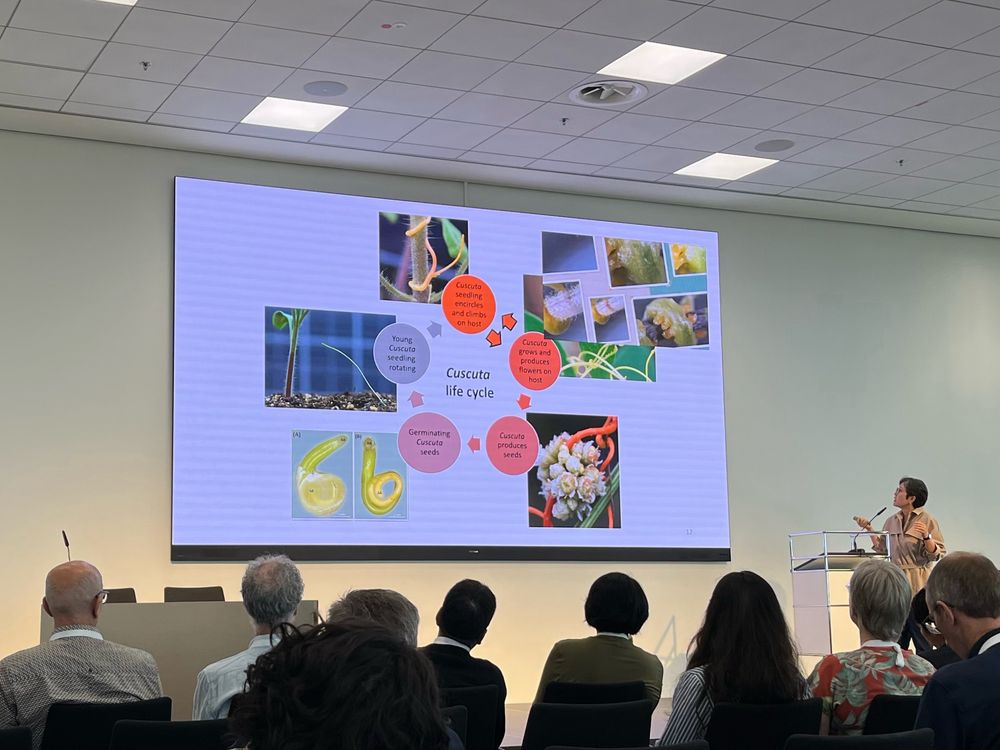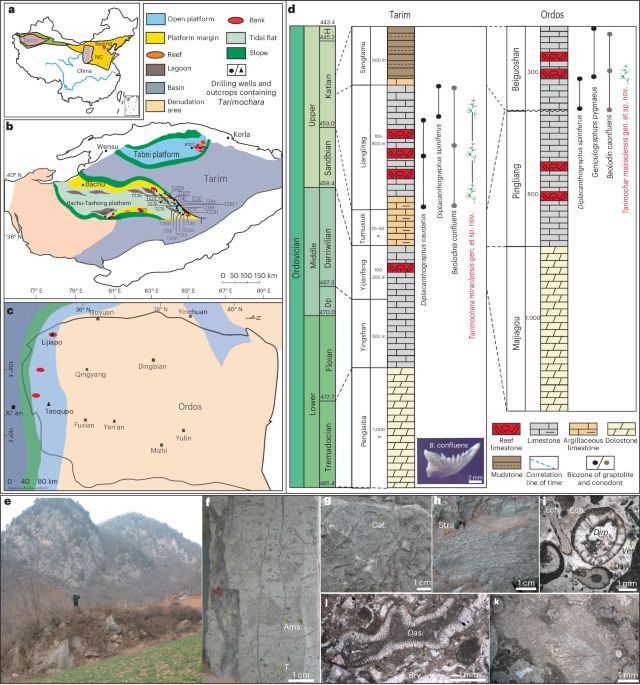
The post shows a picture of Mung after successfully passing her viva on a green background with words congratulating her on acquiring the PhD title.
🌟 We celebrate Dr. Mung Hsia Foo from Hirofumi Nakagami’s lab @mpipz.bsky.social for completing her PhD! 🎓👏 Best of luck for the exciting journey ahead! 🌱
#PhDSuccess #PlantScience #PhDone #ScientificAchievement
27.10.2025 09:35 — 👍 15 🔁 4 💬 0 📌 0

MBE | High Conservation of Translation-Enabling RNA Editing Sites in Hyper-editing Ferns Implies They Are Not Selectively Neutral
@farleykvdg.bsky.social et al. investigate the importance of translation-enabling RNA editing in ferns, suggesting an adaptive role, in contrast to the prevailing view of RNA editing as a neutral evolutionary process.
🔗 doi.org/10.1093/molbev/msaf241
#evobio #molbio #PlantSky
27.10.2025 11:33 — 👍 3 🔁 1 💬 0 📌 0

Resolving the Stasis-Dynamism Paradox: Genome Evolution in Tree Ferns
Abstract. The paradox of evolutionary stasis and dynamism—how morphologically static lineages persist through deep geological periods despite environmental
Wei et al. present chromosome-scale genomes for three ecologically divergent ferns, demonstrating how regulated genomic dynamism enables adaptive diversification while sustaining morphological conservatism.
🔗 doi.org/10.1093/molbev/msaf247
#evobio #molbio #PlantSky
27.10.2025 11:23 — 👍 5 🔁 3 💬 0 📌 0

What if we could chart all cell types across the tree of life?
In @nature.com, @arnausebe.bsky.social and colls launch the Biodiversity Cell Atlas, a global effort to map eukaryotic cell diversity using single-cell & genomic data.
drive.google.com/file/d/1G4zZ... @crg.eu @ibe-barcelona.bsky.social
23.10.2025 21:27 — 👍 45 🔁 9 💬 0 📌 0

Exploring fern pathosystems and immune receptors to bridge gaps in plant immunity - BMC Biology
Land plants include angiosperms, gymnosperms, bryophytes, lycophytes, and ferns, each of which may deploy distinct strategies to resist pathogens. Here, we investigate fern-pathogen interactions by characterizing novel pathosystems and analyzing the diversity of fern immune receptors. A collection of fern species was inoculated with a diverse set of filamentous microbes, and disease symptoms were assessed. We further leveraged published genome mining tools to analyse the diversity of receptor-like kinases, receptor-like proteins (RLKs/RLPs) and nucleotide-binding and leucine-rich repeats (NLRs), along with key immune signalling components, in ferns. Our results reveal that ferns exhibit a range of responses to pathogens, including putative non-host resistance and more specific resistance mechanisms. Among ten ferns tested, Pteris vittata displays the broadest spectrum of pathogen compatibility. Genome mining indicates that ferns encode a diverse repertoire of putative immune receptors, antimicrobial peptides, and mediators of systemic acquired resistance. Ferns possess numerous RLKs/RLPs, resembling those required for cell-surface immunity in angiosperms. They also encode diverse NLRs, including sub-families lost in flowering plants. These findings provide insights into disease resistance evolution and open promising perspectives for crop protection strategies.
1\ bmcbiol.biomedcentral.com/articles/10....
🌿🌿Our article on fern immunity has been peer-reviewed 🌿🌿
Thanks to @madeleinebaker.bsky.social @kellerjeanphd.bsky.social @maximebonhomme.bsky.social @pierremarcdelaux.bsky.social and @jacquet-chris.bsky.social
a quick thread 🧵 1/4
13.10.2025 08:28 — 👍 28 🔁 19 💬 1 📌 3

Various ferns species inoculated with S. sclerotiorum.
Want to see ferns under attack and how they respond to pathogens? Check out our latest paper!
doi.org/10.1186/s129...
Congrats on this huge team effort to @baptistebio.bsky.social @madeleinebaker.bsky.social @kellerjeanphd.bsky.social @maximebonhomme.bsky.social @pierremarcdelaux.bsky.social
09.10.2025 15:40 — 👍 31 🔁 23 💬 0 📌 2

Very happy and proud to share the #Spirogyra genome: 50 Mbp small, lacking almost all plastid division proteins and many transcription factors. Kudos to all the many people involved in this multi year project!
@jandevries.bsky.social
@watertoland.bsky.social
www.biorxiv.org/content/10.1...
11.10.2025 09:20 — 👍 80 🔁 28 💬 2 📌 3

Fig. 2.Confocal microscopy of N. punctiforme strains. Filaments from the indicated strains were taken from cultures grown in BG110 medium (not induced; A) or after incubation for 24 h in the presence of Anthoceros agrestis exudates (hormogonia induction; B) and visualized by confocal microscopy. Merged (2 channels) show the overlay of autofluorescence (magenta) and GFP fluorescence (green). Merged (3 channels) represent the overlay of magenta autofluorescence, bright field, and green GFP fluorescence. Hormogonia are identified as short filaments with small cells. Scale bar=20 μm.
💡🔬 TECHNICAL INNOVATION 💡🔬
Neubauer et al. developed a Nostoc reporter strain enabling high-throughput quantitative monitoring of hormogonia differentiation in cyanobacteria as a response to biotic and abiotic factors.
🔗 doi.org/10.1093/jxb/...
#PlantScience 🧪 @peterszovenyi.bsky.social
24.09.2025 11:31 — 👍 9 🔁 7 💬 0 📌 0
Join us for the 4th annual NonSeed Plant Meeting in Norwich this year! @johninnescentre.bsky.social
12.09.2025 11:21 — 👍 14 🔁 14 💬 2 📌 0

Our @JohnInnesCentre @TheSainsburyLab Friday seminar today is hosted by Hyeonmin @Hynmn_Jeong / Susana Coelho on the curious world of brown algae 👀
12.09.2025 10:42 — 👍 20 🔁 4 💬 0 📌 0

Graphical abstract of the paper "Starting strong: development and biomechanics of the seedling–host interaction in European mistletoe (Viscum album)". The graphic shows mistletoe seedlings developing over the course of the year, and has depictions of the forces acting to facilitate mistletoe establishment.
🌱 RESEARCH 🌱
Mistletoe forms a strong attachment to the host already at the seedling stage by combining an interlocking mechanism with the hypocotyl, forming a bridge-like structure that strengthens the parasite–host connection - Teixeira-Costa et al.
🔗 doi.org/10.1093/jxb/...
#PlantScience 🧪
06.09.2025 11:14 — 👍 19 🔁 7 💬 0 📌 1
A synthetic ERFVII-dependent circuit in yeast sheds light on the regulation of early hypoxic responses of plants https://www.biorxiv.org/content/10.1101/2025.09.01.673502v1
05.09.2025 15:08 — 👍 1 🔁 1 💬 0 📌 0

So very proud of my student George Greiff for winning the David Hanke Medal for the best student talk at this year’s Gatsby Plant Science network meeting in Oxford. Well deserved at the end of a busy and productive PhD 👏🏻💕.
05.09.2025 14:06 — 👍 12 🔁 1 💬 2 📌 1
Ok, hear me out, here's the plan:
19.08.2025 11:08 — 👍 13 🔁 5 💬 0 📌 1
I’m very grateful and excited to start our ARIA-funded project on redesigning plant immunity!
23.07.2025 13:38 — 👍 85 🔁 21 💬 11 📌 1

A roadmap to developing unified streptophyte algal model systems
Carrillo-Carrasco and colleagues highlight the importance of the establishment of
streptophyte algal model systems and the community efforts towards this goal.
We've tried to gather and unite the streptophyte algae community all around the world to join forces and develop tools and methods for these critters. Learn more about it on @currentbiology.bsky.social!
With @jandevries.bsky.social, @dolfweijers.bsky.social, and (many) others!
tinyurl.com/29n4zwen
22.07.2025 09:41 — 👍 43 🔁 29 💬 2 📌 1

Nice and visual talk by Soyon Park about parasitic plant bidirectional communication with their host plant. #2025ISMPMI #parasiticplants #plantscience
16.07.2025 09:27 — 👍 3 🔁 2 💬 0 📌 0
🎉 Exciting news during #2025ISMPMI
Our AlphaFold sensor vs helper NLR paper is now published in @newphyt.bsky.social!
Big thanks to the reviewers for their constructive feedback 🙏
📖 Check out the peer-reviewed version here 👇
🔗 nph.onlinelibrary.wiley.com/doi/10.1111/...
bsky.app/profile/yusu...
16.07.2025 15:57 — 👍 37 🔁 16 💬 1 📌 0
Last chance to apply for the open postdoc position in our lab!
12.07.2025 12:19 — 👍 10 🔁 11 💬 0 📌 0

ERFVIIs as transducers of oxygen-sensing in the evolution of land plant response to hypoxia #research #MolecularPlant cell.com/molecular-pl...
30.05.2025 16:50 — 👍 5 🔁 5 💬 0 📌 0

New Postdoc position (2yrs) available in our #EvoMPMI lab @JohnInnesCentre. Come and work with on harnessing the diversity of immune mechanisms to protect plants. jobs.jic.ac.uk/Details.asp?va…
30.06.2025 13:12 — 👍 46 🔁 51 💬 1 📌 1

1/🚨 New preprint alert! Can mutualists and pathogens co-colonise the same living plant cell and what does that do to the plant membranes that surround these microbes?
24.06.2025 16:54 — 👍 72 🔁 37 💬 7 📌 6
Algae and diatom bioengineer,🌱 Plant Metabolism, Alison Smith Lab, University of Cambridge
Molecular Plant Microbe Interactions @ University of Cologne. Immunity, AVR, receptors, mildews, cereals .....terrible with typos 🤷♀️
@izzysaur
#RussellLab studies #bees #behaviour #microbes & #flower #evolution @MissouriState https://therusselllab.net/
| #PUI | #SciComm #DiversityInSTEM #BLM #WomenInSTEM #Humanities | he/him
Group Leader in plant developmental biology @mpi-mp-potsdam.bsky.social
Details at figueiredolab.com and mpimp-golm.mpg
postdoc @floridamuseum.bsky.social phenomics of insect evolution. toward AI/CV-based museomics. www.luerig.net
BBSRC Discovery Fellow @oxfordbiology.bsky.social | Working on cell-to-cell connectivity in C4 photosynthesis
Group Leader at JIC. Natural product biosynthesis. Streptomyces interactions with plants & insects. Drummer, dad, Norwich City FC.
www.jic.ac.uk/people/matt-hutchings
http://streptomyces.org.uk for strains & resources
Engagement @sawtrust.bsky.social
Algae enthusiast! Post-doc at @mpi-bio-fml.bsky.social
Evolution publishes articles in evolutionary biology focused on evolutionary phenomena and processes at all levels of biological organization. Evolution is owned by the Society for the Study of Evolution and is published by Oxford University Press.
Group leader CRG; Associate Faculty ToL Sanger Institute.
Genome regulation, chromatin, cell types, and evolution. https://www.sebepedroslab.org
Academic (CNRS) research group hunting mechanisms of seaweed growth and development
Diversity, Ecology and Evolution of Microbes (DEEM) team. Posts by David Moreira. #treeoflife #evolution
Paris, France
https://www.deemteam.fr/en/
Virus origins/diversity/evolution; mobilome; Archaea.
Head of the Archaeal Virology Unit at Institut Pasteur:
https://research.pasteur.fr/en/team/archaeal-virology/
News from the Sternberg lab at Columbia University, Howard Hughes Medical Institute.
Posts are from lab members and not Samuel Sternberg unless signed SHS. Posts represent personal views only.
Visit us at www.sternberglab.org
Evolutionary cell biology / evolution of morphogenesis / animal origins / choanoflagellates @institutpasteur.bsky.social
https://research.pasteur.fr/en/team/evolutionary-cell-biology-and-evolution-of-morphogenesis/
Plant biologist working on #symbiosis and #evolution in Toulouse (FR)
Group Leader at University of Zurich.
Evolutionary Genomics of non seed plants.
Lab working on plant natural product biosynthesis from enzymes to evolution
https://lichmanlab.weebly.com/
Postdoc at University of Geneva. Interested in the plant signaling evolution
Professor passionate about student success & team science #firstgen #Brassica enthusiast walking Dogs of the Plant World
#Agriculture #Food #HigherEd #EduSky #Agsky #SciComm & more
#Soil #Crop #Science ; opinions mine






















